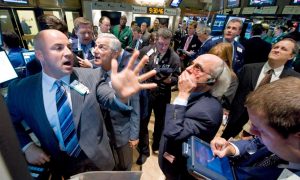OCTOBER 27, 2018

Recent market turbulence, including today’s sharp stock market drop, has been a wakeup call for many investors. Feeling queasy? It isn’t too late to make portfolio changes: The S&P 500 may be down 10% from its all-time high in September, but it’s still up an eye-popping 290% since March 2009.
Why is the stock market down lately? There’s no one factor for how and why the stock market dropped today, or any day. But here are three quick calculations that might spur you to action—or help ease your mind no matter what happens, including if the stock market drops further.
How much cash do you need if the stock market falls for a few year?
If this is the start of a bear market—and that’s a big “if”—the decline and subsequent recovery will likely all be over within five years or so. Consider an extreme example: Let’s say you bought the S&P 500 stocks on Oct. 9, 2007, just as 2007-09’s horrendous 57% decline was beginning. By March 28, 2013, you would have been back to even—and the recovery time was even shorter, if you count the dividends you would have collected over the intervening five-and-a-half years.
The implication: If you’ll need money from your portfolio over the next five years, it should be out of stocks and stashed in a savings account, money-market fund, certificates of deposit or short-term bonds. That way, you don’t run the risk of being forced to sell at fire-sale prices after the stock market drops.
What about money you’ll need after the five-year mark? History suggests that, if you leave it in stocks and hang tough through any market decline, there’s a good chance you’ll be able to cash out at close to today’s prices and probably pocket handsome gains.
Are you near or in retirement? Do the math, and you’ll likely discover you have far more than five years’ worth of portfolio withdrawals in bonds and other conservative investments.
Suppose you need $20,000 in spending money from your portfolio each year, to supplement whatever you get from Social Security and any pension, and you have $250,000 in bonds and other conservative investments. Divide that $250,000 by the $20,000 you need annually. Result: You have 12½ years of portfolio withdrawals stashed in conservative investments—a comforting thought and yet another reason to turn off CNBC.
What’s the biggest stock market drop you can stomach?
Think of this as your “freak out” point when the stock market plunges. You may be that rare fearless investor who doesn’t have one. But many folks do: If their short-term losses are severe enough, there’s a chance they’ll lose all stomach for risk. At that juncture, many folks simply freeze, neither seizing the buying opportunity nor selling in a panic. But others start making drastic and damaging portfolio changes.
The truth is, unless you’ve been through a bear market or two, you probably don’t know whether you have a breaking point or what it is. But the following exercise may help.
Let’s say your investment portfolio is currently worth $500,000 and you’d be devastated to see it fall below $400,000, equal to a $100,000 loss. In a bear market—defined as a stock market drop of 20% or more—the average decline is around 35%.
If your stocks tumbled 35% and you wanted to limit your total dollar loss to $100,000, how much should you allocate to stocks? If you divide $100,000 by 0.35, you have your answer: $285,700. In other words, if you had $285,700—or 57%—of your $500,000 in stocks, and share prices fell 35%, your overall portfolio’s value wouldn’t fall below $400,000.
To be sure, the decline could be worse than 35%, as it was in 2007-09. If you’re really nervous, you could adjust the above calculation to assume a larger drop. But whatever you do, give some thought to your “freak out” point—and think about it in dollars, not percentages, because that’ll make the potential financial pain seem far more real.
Can your savings offset the next stock market drop?
If you’re retired, a bear market doesn’t offer much reason for cheer. Yes, you could take advantage by shifting money from bonds to stocks. But even if you courageously rebalance, the potential performance boost is relatively modest.
By contrast, if you’re still in the workforce and saving regularly, a bear market could prove to be a great moneymaker. Instead of pulling money from your portfolio, you’re adding new cash—and a bear market offers the chance to invest that cash at bargain prices.
True, if you’re still in the workforce, you likely have a far more aggressive asset allocation than those who are retired. You might be at 80% or 90% in stocks, while retirees might be at 50% or 60%. That means a bear market will hit your portfolio far harder than it hits most retirees.
Or maybe not. If you factor in the savings you’ll add to your portfolio in the years ahead, your asset allocation could be more conservative than that of a retiree. Suppose you’re age 40, with a $300,000 portfolio, all of it in stocks. Let’s also suppose you make $100,000 a year, save 15% of your income and plan to retire at age 65.
Run the numbers and you’ll find that, every year for the next 25 years, you’ll add $15,000 in new savings to your financial accounts, for a total of $375,000. Think of those future savings as cash sitting in your portfolio. The upshot: You effectively have a $675,000 nest egg, with 44% in stocks and 56% in cash. That’s a heap of cash that could eventually be invested in stocks. Which raises the question: Should you be fearful of a market decline—or praying it happens?
Courtesy/Source: Money

































































































